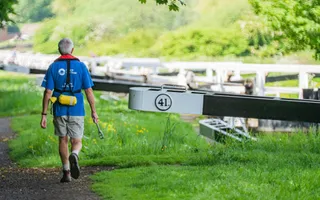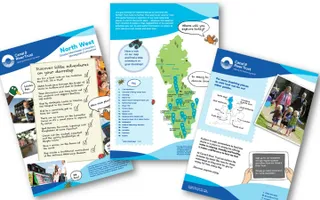Winter works in Hungerford
Watch our video tour of the winter works which took place at our picturesque Grade II listed lock in Hungerford.
The charity making life better by water
Making life better by water
The Kennet & Avon Canal, at 87 miles long, links London with the Bristol Channel, and passes through some spectacular landscapes including Wiltshire and the rolling Cotswolds.
Show me places within...
Explore your nearest canals and ways to enjoy them Find walks, activities and more within:
Watch our video tour of the winter works which took place at our picturesque Grade II listed lock in Hungerford.
Today, thousands of visitors enjoy boating, walking and cycling along the peaceful towpaths of the Kennet & Avon Canal, fondly known as the 'K&A'. This beautiful waterway is a favourite family weekend escape for locals and a pleasure to discover on a day out for visitors. Go to our places to visit pages now to download your free guides to:
But this haven in southern England faced closure in the last century and was only brought back to life thanks to the tireless dedication of volunteers. Just a few decades ago we came very close to losing this national treasure, forever.
What we know as the Kennet & Avon Canal is actually made up of three historic waterways, the Kennet Navigation, the Avon Navigation and the Kennet & Avon Canal.
In 1724 the River Kennet was made navigable from Reading to Newbury, and by 1727 boats could reach as far as Bath. For hundreds of years before this people had talked about linking the River Kennet with the River Avon, but it was not until 1794 that a route was fixed via Devizes and an Act was passed. The resulting canal was completed in 1810.
Water supply up to the summit soon became a problem, so in 1812 a steam engine was installed at Crofton to pump water from Wilton Water (amazingly this Boulton & Watt engine is still working today). Three years later a companion Harvey's engine was also installed.
Despite the impressive length of the Kennet & Avon Canal, through traffic never accounted for more than 6% of the total and the waterway was never prosperous.
The situation worsened for the Kennet & Avon Canal when the Great Western Railway opened in 1841. Suddenly income halved and it seemed likely that the canal would be converted into a railway. Thankfully, however, this Bill was not passed and instead, the canal was sold to the Great Western Railway in 1852.
Although the canal was loss-making, the Great Western Railway was legally obliged to keep it open as long as there was some traffic on it. This it did, though there were many complaints about the level of maintenance. Nevertheless, in 1897 the Boulton & Watt engine had major repairs and a few years later, its companion 1845 engine was rebuilt.
After a century of decline, in the 1960s the canal eventually fell into disrepair and parts of it were closed to boats. The future of the waterway, along with that of many canals, looked bleak.
However, waterway enthusiasts and local people flocked to the cause. The Kennet & Avon Canal Trust was formed and, with hard work and dedication, these volunteers gradually restored the canal to its former glory.
In 1990 the Queen officially reopened the canal, and since then it has gone from strength to strength with the help of a £25m Heritage Lottery Fund grant. Substantial restoration works have been matched by the development of canalside resources, including wildlife habitats and moorings.
Find somewhere beautiful to rest, relax and recharge. Discover what's local to you

Sign up to our newsletter and discover how we protect canals and help nature thrive



